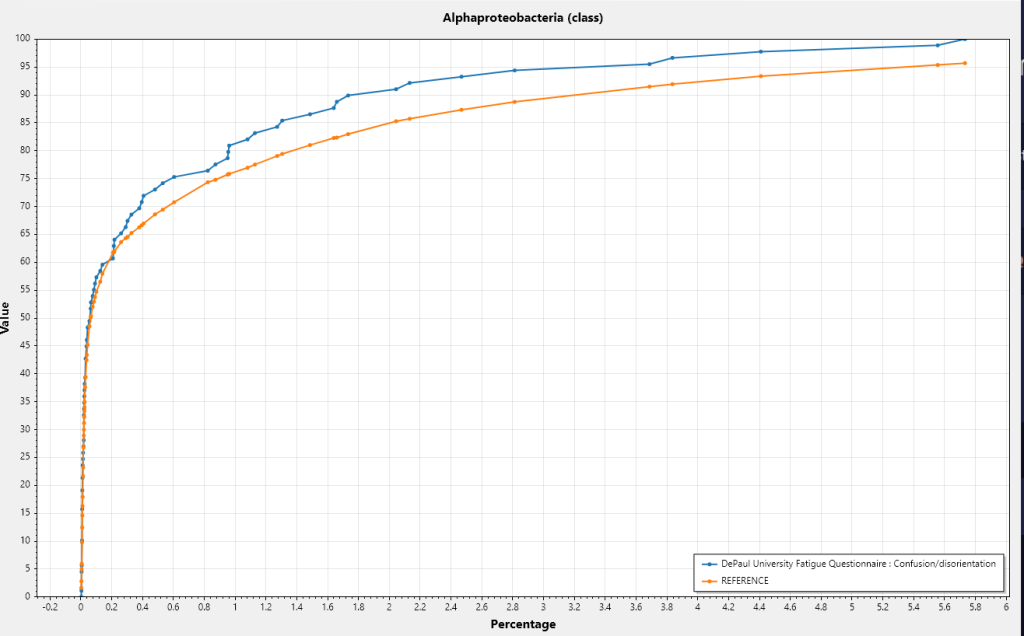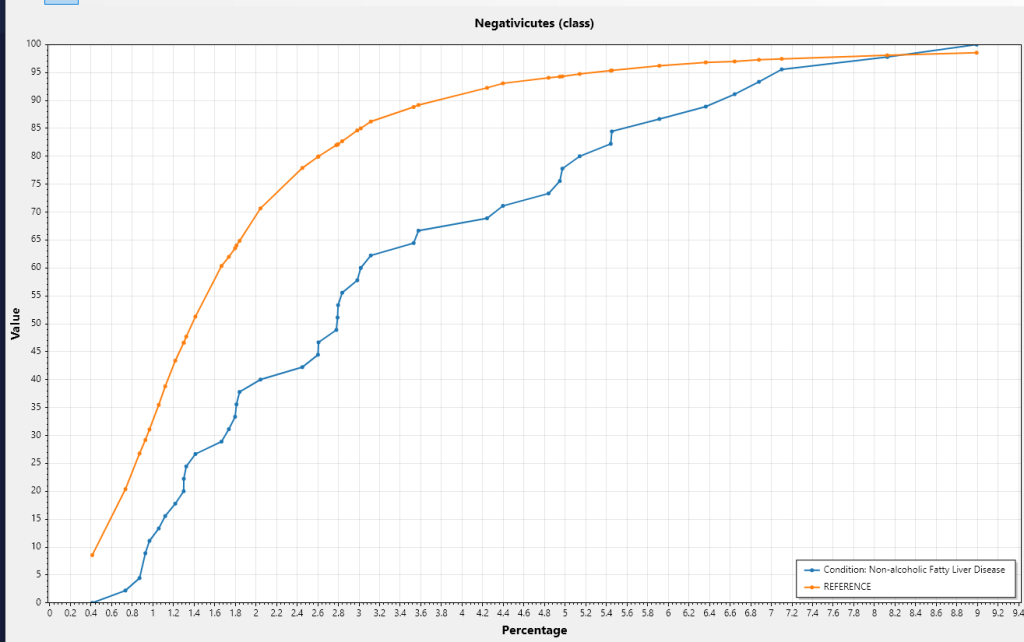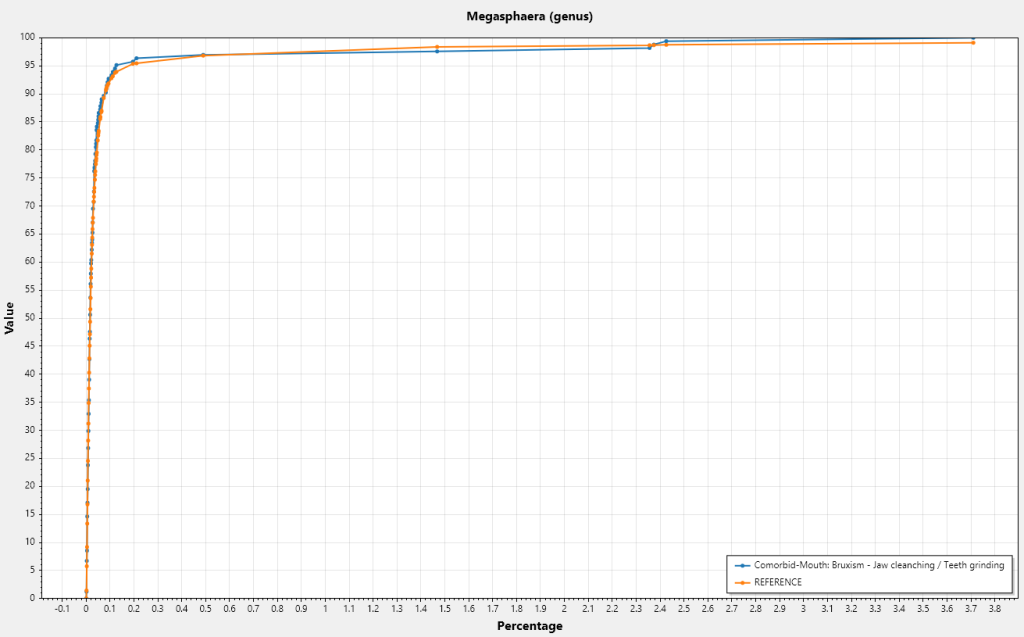This document presents the results of statistical analysis on symptoms from viable, self-annotated Biomesight microbiome samples. The methodology for data acquisition is outlined in New Standards for Microbiome Analysis?.
Tables have been refined to display only genus- and species-level taxa, the 20 most prominent entries per group, and associations achieving statistical significance (P < 0.01).
The following sections provide the processed data, accompanied by guidance on interpretation and application. Counts of significant bacterial taxa are included, reflecting the application of non-standard but rigorously validated statistical approaches to extensive sample and reference populations, where statistical power derives from dataset scale.
| Significance | Genus |
| p < 0.01 | 135 |
| p < 0.001 | 100 |
| p < 0.0001 | 83 |
| p < 0.00001 | 69 |
Averages and Medians
I prefer medians over averages. Medians are the values where half of the people have less and half has more. If the data was a bell-curve, then the values will almost be the same… with bacteria that happens rarely. Look at Bacteroides uniformis below, we see that the average is above and the median below.
If symptom median is higher than reference median, it means there is more of this bacteria. If lower, then less. This ignores how often the bacteria is seen (we average only over reports).
| tax_name | Rank | Symptom Avarage | Reference Average | Symptom Median | Reference Median |
| Bacteroides | genus | 27.303 | 25.835 | 24.008 | 26.554 |
| Bacteroides uniformis | species | 3.026 | 2.68 | 1.498 | 2.016 |
| Phocaeicola dorei | species | 3.35 | 2.83 | 0.379 | 0.672 |
| Coprococcus | genus | 1.354 | 1.444 | 0.739 | 0.612 |
| Bifidobacterium | genus | 0.698 | 0.975 | 0.136 | 0.064 |
| Bacteroides cellulosilyticus | species | 0.883 | 0.849 | 0.07 | 0.138 |
| Bilophila | genus | 0.41 | 0.34 | 0.206 | 0.25 |
| Bacteroides rodentium | species | 0.416 | 0.387 | 0.179 | 0.221 |
| Bilophila wadsworthia | species | 0.4 | 0.331 | 0.197 | 0.235 |
| Bifidobacterium longum | species | 0.244 | 0.336 | 0.052 | 0.03 |
| Anaerotruncus | genus | 0.197 | 0.185 | 0.136 | 0.156 |
| Anaerotruncus colihominis | species | 0.187 | 0.173 | 0.132 | 0.15 |
| Collinsella | genus | 0.146 | 0.189 | 0.057 | 0.042 |
| Collinsella aerofaciens | species | 0.139 | 0.176 | 0.054 | 0.042 |
| Anaerobranca zavarzinii | species | 0.14 | 0.159 | 0.015 | 0.009 |
| Anaerobranca | genus | 0.14 | 0.159 | 0.015 | 0.009 |
| Bifidobacterium adolescentis | species | 0.281 | 0.305 | 0.013 | 0.007 |
| Oxalobacter | genus | 0.033 | 0.03 | 0.018 | 0.023 |
| Bifidobacterium choerinum | species | 0.037 | 0.052 | 0.012 | 0.007 |
| Acholeplasma hippikon | species | 0.051 | 0.042 | 0.006 | 0.01 |
Bacteria Incidence – How often is it reported
The common sense belief is that if a bacteria is reported more often, then the amount should be higher. This is often not true. The microbiome is a complex thing. Look at Bacteroides uniformis below, we see that the average is above and the median below
| tax_name | Rank | Incidence Odds Ratio | Chi2 | Symptoms % | Reference % |
| Aggregatibacter | genus | 0.75 | 7.4 | 18.5 | 24.7 |
| Prevotella bivia | species | 1.29 | 6.6 | 24.4 | 19 |
| Bifidobacterium scardovii | species | 0.71 | 7.1 | 12.4 | 17.3 |
More or Less often based on Symptom Median All Incidence
This is a little more complex to understand. If we compute the mid point for people with the symptom, then if the bacteria was not involved then half of the reference should be above this value and half below this value. If not, it means that the symptom tends to over or under growth.
| tax_name | Rank | Symptom Median | Odds Ratio | Chi2 | Below | Above |
| Psychrobacter glacialis | species | 0.002 | 0.37 | 81 | 584 | 215 |
| Chromatium | genus | 0.002 | 0.38 | 69.5 | 466 | 175 |
| Chromatium weissei | species | 0.002 | 0.38 | 69.2 | 465 | 175 |
| Niabella | genus | 0.002 | 0.4 | 65.2 | 500 | 199 |
| Actinopolyspora | genus | 0.002 | 0.4 | 64.4 | 482 | 191 |
| Thiorhodococcus | genus | 0.002 | 0.43 | 57.4 | 516 | 221 |
| Syntrophomonas sapovorans | species | 0.002 | 0.43 | 55.9 | 477 | 203 |
| Thermodesulfovibrio thiophilus | species | 0.002 | 0.44 | 52.9 | 480 | 210 |
| Thermodesulfovibrio | genus | 0.002 | 0.46 | 50.9 | 554 | 255 |
| Oenococcus | genus | 0.002 | 0.46 | 50.7 | 528 | 241 |
| Helicobacter suncus | species | 0.002 | 0.49 | 46.3 | 656 | 324 |
| Desulfofundulus | genus | 0.002 | 0.47 | 41.9 | 434 | 206 |
| Caldithrix | genus | 0.002 | 0.52 | 36.7 | 541 | 282 |
| Desulfotomaculum defluvii | species | 0.003 | 0.56 | 36.2 | 906 | 508 |
| Viridibacillus | genus | 0.002 | 0.52 | 33.7 | 430 | 222 |
| Streptococcus infantis | species | 0.003 | 0.56 | 33.2 | 707 | 396 |
| Sporotomaculum syntrophicum | species | 0.003 | 0.58 | 32.4 | 996 | 582 |
| Alkalibacterium | genus | 0.003 | 0.58 | 31.6 | 792 | 456 |
| Hydrogenophilus | genus | 0.003 | 0.59 | 31.6 | 994 | 585 |
| Pelagicoccus | genus | 0.002 | 0.58 | 30.7 | 750 | 433 |
More or Less often based on Reference Median All Incidence
This is like the above, but with a different line in the sand. Instead of the median of those with the condition, we use the median of the reference set.
| tax_name | Rank | Reference Median | Odds Ratio | Chi2 | Below | Above |
| Psychrobacter glacialis | species | 0.002 | 0.37 | 141.3 | 584 | 215 |
| Bacteroides heparinolyticus | species | 0.003 | 0.49 | 114 | 849 | 412 |
| Chromatium | genus | 0.002 | 0.38 | 113.2 | 466 | 175 |
| Chromatium weissei | species | 0.002 | 0.38 | 112.6 | 465 | 175 |
| Odoribacter denticanis | species | 0.005 | 0.56 | 110.5 | 1455 | 822 |
| Niabella | genus | 0.002 | 0.4 | 109.6 | 500 | 199 |
| Actinopolyspora | genus | 0.002 | 0.4 | 107 | 482 | 191 |
| Thiorhodococcus | genus | 0.002 | 0.43 | 99 | 516 | 221 |
| Syntrophomonas sapovorans | species | 0.002 | 0.43 | 93.7 | 477 | 203 |
| Thermodesulfovibrio | genus | 0.002 | 0.46 | 91.2 | 554 | 255 |
| Helicobacter suncus | species | 0.002 | 0.49 | 89.5 | 656 | 324 |
| Thermodesulfovibrio thiophilus | species | 0.002 | 0.44 | 89.5 | 480 | 210 |
| Oenococcus | genus | 0.002 | 0.46 | 89.2 | 528 | 241 |
| Desulfotomaculum defluvii | species | 0.003 | 0.56 | 81.7 | 906 | 508 |
| Sporotomaculum syntrophicum | species | 0.003 | 0.58 | 76.8 | 996 | 582 |
| Hydrogenophilus | genus | 0.003 | 0.59 | 74.9 | 994 | 585 |
| Desulfosporosinus | genus | 0.0025 | 1.67 | 71.5 | 600 | 1004 |
| Clostridium taeniosporum | species | 0.003 | 0.62 | 70.1 | 1184 | 734 |
| Desulfofundulus | genus | 0.002 | 0.47 | 69.5 | 434 | 206 |
| Alkalibacterium | genus | 0.003 | 0.58 | 68.1 | 792 | 456 |
More or Less often based on Symptom Median High Incidence
Above we see that many of the top bacteria identified are sparse, that is not reported often. We then restrict them to those that occur above 50% or the time.
| tax_name | Rank | Symptom Median Freq | Odds Ratio | Chi2 | Below | Above |
| Clostridium taeniosporum | species | 0.003 | 0.62 | 27.2 | 1184 | 734 |
| Mycoplasmopsis edwardii | species | 0.005 | 0.67 | 21.1 | 1580 | 1053 |
| Dethiosulfovibrio | genus | 0.004 | 0.67 | 20 | 1335 | 893 |
| Tetragenococcus doogicus | species | 0.003 | 0.67 | 18.8 | 1206 | 813 |
| Hydrocarboniphaga daqingensis | species | 0.004 | 0.72 | 13.8 | 1422 | 1022 |
| Mycoplasmopsis | genus | 0.005 | 0.74 | 12 | 1550 | 1142 |
| Pediococcus | genus | 0.004 | 0.75 | 10 | 1141 | 855 |
| Tetragenococcus | genus | 0.003 | 0.76 | 9.2 | 1183 | 899 |
| Propionispora hippei | species | 0.005 | 0.77 | 8.5 | 1348 | 1039 |
| Propionispora | genus | 0.005 | 0.77 | 8.5 | 1348 | 1039 |
| Phocaeicola coprocola | species | 0.004 | 0.78 | 7.2 | 1068 | 836 |
| Porphyromonas canis | species | 0.005 | 0.8 | 6.6 | 1382 | 1100 |
More or Less often based on Reference Median High Incidence
Above we see that many of the top bacteria identified are sparse, that is not reported often. We then restrict them to those that occur above 50% or the time.
| tax_name | Rank | Reference Median Freq | Odds Ratio | Chi2 | Below | Above |
| Psychrobacter glacialis | species | 0.002 | 0.37 | 141.3 | 584 | 215 |
| Bacteroides heparinolyticus | species | 0.003 | 0.49 | 114 | 849 | 412 |
| Chromatium | genus | 0.002 | 0.38 | 113.2 | 466 | 175 |
| Chromatium weissei | species | 0.002 | 0.38 | 112.6 | 465 | 175 |
| Odoribacter denticanis | species | 0.005 | 0.56 | 110.5 | 1455 | 822 |
| Niabella | genus | 0.002 | 0.4 | 109.6 | 500 | 199 |
| Actinopolyspora | genus | 0.002 | 0.4 | 107 | 482 | 191 |
| Thiorhodococcus | genus | 0.002 | 0.43 | 99 | 516 | 221 |
| Syntrophomonas sapovorans | species | 0.002 | 0.43 | 93.7 | 477 | 203 |
| Thermodesulfovibrio | genus | 0.002 | 0.46 | 91.2 | 554 | 255 |
| Helicobacter suncus | species | 0.002 | 0.49 | 89.5 | 656 | 324 |
| Thermodesulfovibrio thiophilus | species | 0.002 | 0.44 | 89.5 | 480 | 210 |
| Oenococcus | genus | 0.002 | 0.46 | 89.2 | 528 | 241 |
| Desulfotomaculum defluvii | species | 0.003 | 0.56 | 81.7 | 906 | 508 |
| Sporotomaculum syntrophicum | species | 0.003 | 0.58 | 76.8 | 996 | 582 |
| Hydrogenophilus | genus | 0.003 | 0.59 | 74.9 | 994 | 585 |
| Desulfosporosinus | genus | 0.0025 | 1.67 | 71.5 | 600 | 1004 |
| Clostridium taeniosporum | species | 0.003 | 0.62 | 70.1 | 1184 | 734 |
| Desulfofundulus | genus | 0.002 | 0.47 | 69.5 | 434 | 206 |
| Alkalibacterium | genus | 0.003 | 0.58 | 68.1 | 792 | 456 |
Summary
A large number of bacterial taxa exhibit shifts with P < 0.01 in association with this condition. The subsequent challenge is determining how to modulate these taxa, since the volume of candidates exceeds what most individuals can practically consider. Moreover, for many of the taxa identified, there is no published evidence in the U.S. National Library of Medicine describing how to alter their abundance.
A deep optimization model, such as the one implemented on the Microbiome Taxa R2 site, can be used to inform probiotic selection. This model provides coverage for each identified taxon and infers which probiotics are most likely to shift their levels. Its output may then be integrated with more conventional recommendations derived from literature indexed in the U.S. National Library of Medicine where such evidence exists, with the two recommendation sets reconciled by giving priority to probiotic-based suggestions.
Development of a dedicated database based on Biomesight samples is in progress. The current model uses data contributed by PrecisionBiome, and datasets generated with differing laboratory processing pipelines cannot be safely combined, as discussed in The taxonomy nightmare before Christmas…. Once the Biomesight-specific database is complete, an option for generating (offline-only) personalized suggestions will be added to the Microbiome Prescription website.
Probiotics Suggestions
The following are based on a simplified algorithm using R2 data for Biomesight. These are tentative numbers subject to future refinements. Bacteria listed are only for probiotics detected with Biomesight tests. Probiotics include some that are available only in some countries and some that are pending approval for retail sale.
- Good Count: Number of bacteria expected to shift in desired direction
- Bad Count: Number of bacteria expected to shift in wrong direction
- Impact: Estimator of impact based on Chi-2, Slope and R2 vectors
| Probiotic Species | Impact | Good Count | Bad Count |
| Segatella copri | 11.24 | 1 | 0 |
| Lactobacillus helveticus | 10.17 | 2 | 2 |
| Bifidobacterium breve | 6.17 | 1 | 0 |
| Bifidobacterium longum | 5.98 | 1 | 0 |
| Bifidobacterium adolescentis | 4.67 | 1 | 0 |
| Bifidobacterium bifidum | 1.67 | 1 | 0 |
| Bifidobacterium catenulatum | 1.04 | 1 | 0 |
| Blautia wexlerae | 0.71 | 1 | 0 |
| Bifidobacterium animalis | 0.7 | 1 | 0 |
| Enterococcus faecalis | 0.17 | 2 | 3 |
| Limosilactobacillus reuteri | 0.14 | 3 | 0 |
| Enterococcus durans | 0.11 | 5 | 1 |
| Lactobacillus johnsonii | 0.11 | 3 | 0 |
| Lactococcus lactis | 0.09 | 1 | 0 |
| Limosilactobacillus vaginalis | 0.03 | 3 | 1 |
| Bifidobacterium pseudocatenulatum | 0.02 | 2 | 1 |
| Escherichia coli | 0.02 | 1 | 0 |
| Lacticaseibacillus rhamnosus | 0.02 | 1 | 0 |
| Enterococcus faecium | 0.01 | 1 | 1 |
| Akkermansia muciniphila | -0.01 | 0 | 1 |
| Ligilactobacillus salivarius | -0.01 | 0 | 1 |
| Bacillus subtilis | -0.02 | 4 | 3 |
| Lactobacillus jensenii | -0.02 | 2 | 2 |
| Lactobacillus crispatus | -0.03 | 1 | 3 |
| Pediococcus acidilactici | -1.09 | 2 | 3 |
| Bacteroides uniformis | -32.26 | 0 | 1 |
| Bacteroides thetaiotaomicron | -33.35 | 0 | 1 |









Recent Comments